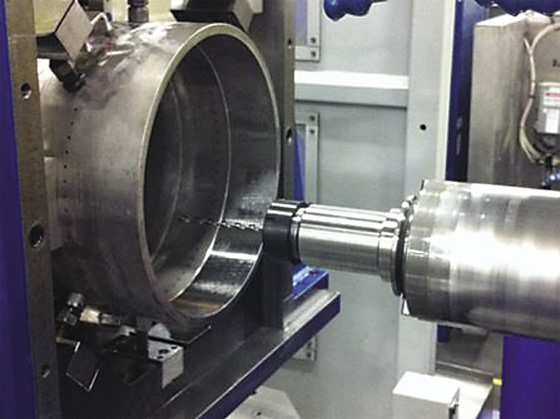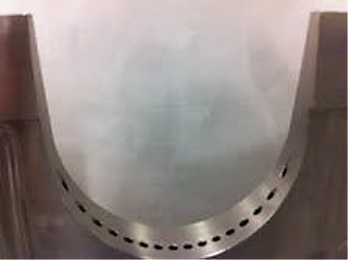Holemaking has significantly advanced in the last 15 years. High-performance drills, when paired with capable machine tools, can eliminate reaming and boring. For example, improved tip geometries provide penetration rates that are almost unbelievable compared to previous standards, and coating improvements significantly extend tool life.
All things considered, however, the most significant advances have been in deep-hole drilling. There is no official definition for deep-hole drilling, but most drill manufacturers consider any hole 15 diameters deep or more to be a “deep hole.” The definition also includes making the hole in one pass with no external support for the drill.

A 6mm (0.236 ") drill produces a hole 20 diameters deep on a horizontal boring mill. Mitsubishi Hitachi Power Systems Americas typically performs deep-hole drilling in the horizontal position to aid chip evacuation.
Uniform nomenclature describes these long drills. Because drill length is specified as a function of the diameter, it is common to see the drill length called out as 15D, 20D and so on. For example, 20D means the drill can produce a hole 20 diameters deep. Therefore, a ½ "-dia., 20D drill can produce a 10 "-deep hole.
Making these holes is a challenge, because long drills tend to “walk,” or drift, from the intended direction, resulting in off-center holes. In addition, chips can get packed in the hole, leading to drill breakage, and drilling speeds can be slow.
New drill geometries and drilling techniques can combat most of these problems and allow machinists and engineers to perform operations that might otherwise require a secondary process on a separate piece of equipment. To prevent walking, drills are made to be self-supporting so the flutes fit closely inside the hole. This allows the hole walls to support the drill, similar to a drill bushing. The tools are also ground so that the drill diameter tapers towards the shank. This slight taper ensures only the point end of the drill contacts the part, preventing the drill from binding.
Machine tool advancements have also enhanced deep-hole drilling. Through-spindle coolant is probably the most significant. When making a hole that is 15, 20 or sometimes 50 diameters deep, chip evacuation is the primary concern. Even when drilling shallow holes, it is common to use a peck cycle or withdraw the drill from the hole to expel chips.

The holes in this turbine component are 2.4mm (0.095 ") in diameter and 55mm (2.16 ") deep, about 20 diameters deep. Deep-hole drilling eliminates the need for a secondary process, such as EDMing.
However, withdrawing the drill increases cycle time and may break the drill, so it is beneficial to expel the chips without withdrawing. Through-spindle coolant applied at 300 psi or higher can force chips from a deep hole without pecking or withdrawing the drill. It also ensures there is ample coolant at the point to prevent overheating.
Hydraulic and shrink-fit toolholders have also advanced deep-hole drilling by minimizing drill tip runout. Runout can cause a drill tip to walk off center and generate a hole that is not straight. It can also cause the drill to whip—imagine two girls swinging a jump rope—and break.
It is easy to justify the expense of high-quality toolholders when deep-hole drilling because a broken drill can be costly. Not only does a high-performance drill cost several hundred dollars or more, but a valuable part could be scrapped when a piece of carbide from a broken drill becomes embedded in the part. To prevent that catastrophic event, a monitoring device on the machine tool can sense dull and broken drills and stop the machine.
The primary benefit of deep-hole drilling is minimizing the need for secondary operations. In the past, many deep holes would have required the use of a secondary piece of equipment, such as an EDM. With improvements in drilling technology, it is possible to drill challenging holes on standard machines while performing other machining operations.
Deep-hole drilling also gives design engineers more freedom. Having the ability to efficiently drill deep holes can eliminate the need for multiple components and drive advances in component design that enhance overall component performance.
Several manufacturing engineers and machinists I have worked with were afraid to try deep-hole drilling, preferring to rely on older methods. However, it is a safe and effective process, and an application engineer from a toolmaker can successfully guide users through setup and programming. CTE
About the Author: Christopher Tate is engineering manager, combustion shop, for Mitsubishi Hitachi Power Systems Americas, Savannah (Ga.) Machinery Works, a global builder of gas and steam turbines. He has 20 years of experience in the metalworking industry and holds a Master of Science and Bachelor of Science from Mississippi State University. Email: [email protected].Related Glossary Terms
- boring
boring
Enlarging a hole that already has been drilled or cored. Generally, it is an operation of truing the previously drilled hole with a single-point, lathe-type tool. Boring is essentially internal turning, in that usually a single-point cutting tool forms the internal shape. Some tools are available with two cutting edges to balance cutting forces.
- bushing
bushing
Cylindrical sleeve, typically made from high-grade tool steel, inserted into a jig fixture to guide cutting tools. There are three main types: renewable, used in liners that in turn are installed in the jig; press-fit, installed directly in the jig for short production runs; and liner (or master), installed permanently in a jig to receive renewable bushing.
- coolant
coolant
Fluid that reduces temperature buildup at the tool/workpiece interface during machining. Normally takes the form of a liquid such as soluble or chemical mixtures (semisynthetic, synthetic) but can be pressurized air or other gas. Because of water’s ability to absorb great quantities of heat, it is widely used as a coolant and vehicle for various cutting compounds, with the water-to-compound ratio varying with the machining task. See cutting fluid; semisynthetic cutting fluid; soluble-oil cutting fluid; synthetic cutting fluid.
- electrical-discharge machining ( EDM)
electrical-discharge machining ( EDM)
Process that vaporizes conductive materials by controlled application of pulsed electrical current that flows between a workpiece and electrode (tool) in a dielectric fluid. Permits machining shapes to tight accuracies without the internal stresses conventional machining often generates. Useful in diemaking.
- flutes
flutes
Grooves and spaces in the body of a tool that permit chip removal from, and cutting-fluid application to, the point of cut.
- metalworking
metalworking
Any manufacturing process in which metal is processed or machined such that the workpiece is given a new shape. Broadly defined, the term includes processes such as design and layout, heat-treating, material handling and inspection.
- milling machine ( mill)
milling machine ( mill)
Runs endmills and arbor-mounted milling cutters. Features include a head with a spindle that drives the cutters; a column, knee and table that provide motion in the three Cartesian axes; and a base that supports the components and houses the cutting-fluid pump and reservoir. The work is mounted on the table and fed into the rotating cutter or endmill to accomplish the milling steps; vertical milling machines also feed endmills into the work by means of a spindle-mounted quill. Models range from small manual machines to big bed-type and duplex mills. All take one of three basic forms: vertical, horizontal or convertible horizontal/vertical. Vertical machines may be knee-type (the table is mounted on a knee that can be elevated) or bed-type (the table is securely supported and only moves horizontally). In general, horizontal machines are bigger and more powerful, while vertical machines are lighter but more versatile and easier to set up and operate.
- shank
shank
Main body of a tool; the portion of a drill or similar end-held tool that fits into a collet, chuck or similar mounting device.


